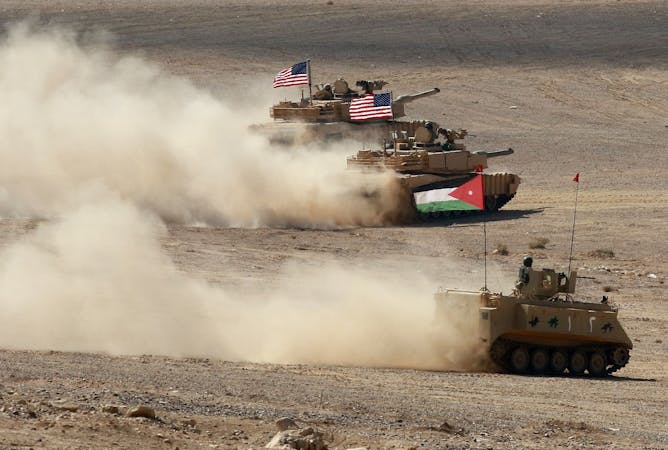|
|
|
|
Top headlines
Lead story
Since the current war between Israel and Hamas began in early October, there have been warnings of the conflict spiraling and igniting proxy wars in the Middle East.
Sporadic fighting on Israel’s northern border with Lebanon and Houthi raids in the Red Sea ratcheted up the tension, for sure. But until Sunday, the U.S. administration had avoided the need to address a deadly attack on any of its personnel in the region.
But then a drone attack in Jordan killed three American troops and injured dozens more, forcing President Joe Biden’s hand. He immediately blamed Iran-backed militias; Tehran denied having any involvement. The relationship between Iran and the group that claimed responsibility is not straightforward, as Sara Harmouch, an expert on asymmetric warfare and militant groups in the Middle East at American University, explains. And that complicates the calculus in front of Biden now as he prepares a retaliatory response. How he acts, Harmouch adds, risks provoking an escalation and might even “reshape the Middle East’s geopolitical landscape and influence the
dynamics of proxy warfare in the region.”
[ Sign up for our weekly Global Economy & Business newsletter, with interesting perspectives from experts around the world. ]
|

|
Matt Williams
Senior International Editor
|
|

Jordanian and U.S. tanks take part in joint maneuvers in September 2022.
Khalil Mazraawi/AFP
Sara Harmouch, American University
Three American troops were killed and dozens more injured in an attack on a base in Jordan. How the Biden administration responds could determine if conflict in the Middle East widens.
|
Health + Medicine
|
-
G. Samantha Rosenthal, Roanoke College
For as long as trans medicine has been around, so has its opposition. The tactics of prior waves of anti-trans policies are still in play today.
-
Leah Koenig, University of California, San Francisco; Ushma Upadhyay, University of California, San Francisco
People of color, young people and those with low incomes tend to benefit most from telehealth abortion.
|
|
Science + Technology
|
-
Erik Christian Olstad, University of California, Davis
Dogs might have furry coats, but they can still get cold when the temperature drops.
-
Amy Pritchett, Penn State
An air traffic safety expert explains why humans will remain central to managing the nation’s airports and airspace even as AI promises to improve air traffic control.
|
|
Ethics + Religion
|
-
Vasudha Narayanan, University of Florida
A scholar of Hinduism explains the importance of the consecration ritual, which is believed to bring the presence of the divine into the temple.
|
|
Politics + Society
|
-
Erica Frantz, Michigan State University; Andrea Kendall-Taylor, Yale University; Joseph Wright, Penn State
A second Trump presidency may be a danger to democracy, but that’s more to do with the Republican Party than Trump himself, researchers of authoritarianism explain.
-
Donovan Schaefer, University of Pennsylvania
At the turn of the 20th century, Southern sympathizers started building monuments to Confederate leaders. Black newspaper editors saw these emblems clearly for what they stood for – a lost cause.
-
Cari Babitzke, Boston University
Under his watch, congressional action toward gun control ground to a near halt that lasted for many years.
|
|
Environment + Energy
|
-
Qian Cao, University of California, San Diego
These giant rivers in the sky are bringing more intense rainfall as the planet warms.
-
Eleanor Putnam-Farr, Jones Graduate School of Business at Rice University
Retail stores in Boulder, Colo., banned plastic bags and will charge 10 cents for paper bags in an effort to reduce plastic waste. But do bans and taxes like this really work?
|
|
|
|
|
|
| |
| |
| |
| |
|
|
|
|
|
|
|